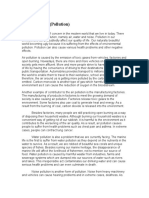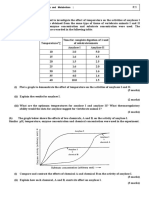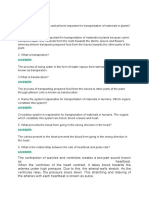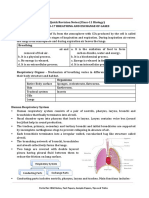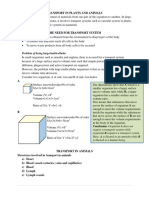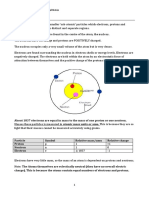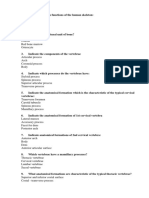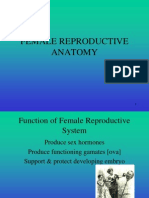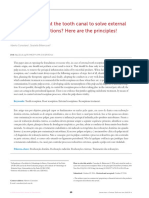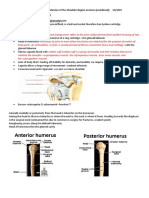Biology 12 - Enzymes & Metabolism
Biology 12 - Enzymes & Metabolism
Uploaded by
John Reeve InsoyCopyright:
Available Formats
Biology 12 - Enzymes & Metabolism
Biology 12 - Enzymes & Metabolism
Uploaded by
John Reeve InsoyOriginal Description:
Copyright
Available Formats
Share this document
Did you find this document useful?
Is this content inappropriate?
Copyright:
Available Formats
Biology 12 - Enzymes & Metabolism
Biology 12 - Enzymes & Metabolism
Uploaded by
John Reeve InsoyCopyright:
Available Formats
Name: Block: Date:
BIOLOGY 12 - ENZYMES & METABOLISM
• Part A: Definitions: Define the following terms, IN YOUR
OWN WORDS, IN AS FEW WORDS AS CLARITY AND
COMPLETENESS ALLOW.
i. metabolism all the chemical reactions that take place in living systems to
maintain homeostasis
ii. substrate the substances that enter a specific reaction
iii. enzyme proteins that serve as catalysts (they speed up reactions)
iiii. active site the place on an enzyme where substrate(s) bind
v. apoenzyme the protein part of an enzyme, gives the enzyme its specificity
vi. coenzyme non-protein organic molecules (e.g. NAD+) that help enzymes to
catalyze reactions or carry electrons, hydrogen, or functional groups
stripped from substrates. Often complete the active site.
vii. metabolic a stepwise sequence of reactions in cells, with specific enzymes
pathway catalyzing each step.
viii. activation energy the minimum amount of energy that colliding reactants must have in
order for a chemical reaction to occur.
Part B: Short Answers
1. The equation ADP + Pi ATP is energy (requiring or
releasing) requiring.
2. In the pathway below, the letters stand for substrates
and the numbers stand for enzymes. Each and every
reaction in a cell requires a specific enzyme.
1 2 3 4
A B C D E
3. I f an enzymatic reaction is heated gently, it will speed
up.
4. Enzymes LOWER the amount of activation energy
necessary for a reaction to take place by putting its
substrates on a precise “collision course.”
5. When NAD accepts hydrogens from a substrate, it is
reduced, while the substrate is oxidized.
6. In the equation S + E SE P + E, what do the letters stand
for?
S: substrate P: product
SE: substrate-enzyme complex E: enzyme
7. ame two environmental factors that can change the
N
shape of an enzyme.
http://terrimosher.weebly.com/uploads/4/8/5/7/4857713/worksheet_-_enzymes_a_key.doc 08/11/2019, 10E49 PM
Page 1 of 5
i. temperature ii. pH
8. Name two factors that can speed up enzymatic reactions
i. increase temp ii. increase [] of substrate or
enzyme
9. nzymes have helpers called coenzymes. A common
E
example of the latter is NAD. What is the function of NAD
in cells? Carries H atoms in oxidation reduction
reactions.
10. Give the overall equation for aerobic cellular respiration.
Indicate energy on the correct side.
C6H12O6 + 6O2 --------> 6CO2 + 6H2O + 38 ATP
Food + oxygen carbon + Water + Energy
(Glucose) dioxide
11. In a metabolic pathway, a) the product of one reaction
becomes the substrate of the next reaction b) the same
enzyme is used for all reactions c) the end product is
always pyruvic acid d) ATP is used up all the time e) all of
these correct answer = a
1 ENZYME
2 COENZYME
3 SUBSTRATE
4 PRODUCT
12. Label the parts on the diagram to the right.
13. Label all missing parts on the graphs to the right.
Highlight the energy of activation on both graphs.
14. Which graph below best represents a graph of the
Enzyme activity vs pH? D
http://terrimosher.weebly.com/uploads/4/8/5/7/4857713/worksheet_-_enzymes_a_key.doc 08/11/2019, 10E49 PM
Page 2 of 5
Part C: Thinking Questions - Answer on separate sheets
of paper, in your OWN WORDS.
1. What advantages can you see in having complex metabolic pathways within body cells to produce various
substances, such as amino acids and ATP?
• more control over reactions (can be halted/modified/sped up/slowed down at any step).
• more sophisticated reactions possible, so more complex molecules can be made
• intermediate products can be used in other pathways
• cyclic pathways/feedback mechanisms possible
2. What gland produces the hormone thyroxin? What is the function of thyroxin in metabolism?
Thyroid gland. Thyroxin increases cellular metabolism (increases oxygen uptake, protein synthesis etc.)
3. Explain, using a good example, how a metabolic pathway can be self-regulating (that is, how it can shut itself on and
off).
• The amino acid aspartate becomes the amino acid threonine by a sequence of 5 enzymatic reactions. When threonine,
the end product of this pathway, is present in excess, it binds to an allosteric site on enzyme 1, and then the active site
is no longer able to bind aspartate.
4. How does the “Lock and Key” theory of enzyme action differ from the “Induced Fit” theory? Use diagrams to help your
explanation.
In Induced Fit model, once the substrate binds the enzyme, the enzyme changes shape to more tightly bind the substrate.
In Lock & Key model, E and S fit each other perfectly before they bind. See notes for diagrams
5. Why do you think each enzyme has its own preferred pH at which it operates?
• Changes in pH cause conformation changes (denaturing) in proteins (because they disrupt bonds holding the enzyme in
its precise shape). Changes in E shape at active site will impair or destroy its substrate-binding ability.
6. What is the effect of lowering the temperature on enzyme activity. How about raising the temperature? Draw a graph to
show these relationships.
Lowering temperature lowers the rate of activity (but does not usually denature the enzyme). Raising the temperature
moderately (e.g. from 37 degrees to 40 degrees) raises the rate of reaction. Raising the temperature a large amount
(e.g. from 37 degrees to 50 degrees) will denature the enzyme.
7. Describe three factors that can lead to the denaturing of enzymes. How would denaturing an enzyme affect its
activity?
• Factors:
1) pH 2) high temperature 3) heavy metals 4) specific chemicals (e.g. HCN)
• The bonds that hold enzyme together become disrupted, causing the Enzyme to lose its precise 3D tertiary
structure/quaternary structure.
8. What happens to the rate of product formation if you continue to add to an enzyme-catalyzed reaction the following:
+ =
a) substrate b) enzyme c) an inhibitor d) Lead, mercury, or cadmium e) H ions f) OH ions
• a) Increase until enzymes saturated b) increase as long as substrate present c) decrease d) decrease and can cause
denaturing e) decrease and can cause denaturing f) decrease and can cause denaturing
9. Explain, using diagrams, how competitive inhibitors differ from non-competitive inhibitors in the way they act on
enzymes.
Competitive is on the left, non-competitive is on the right. Both slow the rate of reaction.
http://terrimosher.weebly.com/uploads/4/8/5/7/4857713/worksheet_-_enzymes_a_key.doc 08/11/2019, 10E49 PM
Page 3 of 5
10. Discuss, using examples, the effects of reversible and non-reversible inhibitors on enzyme activity.
• Reversible inhibitors will slow down enzyme action. The more inhibitor that is added, the more the activity slows. e.g.
threonine. Non-reversible inhibitors will slow down enzyme action. Each inhibitor will destroy an enzyme. If enough I
added, E activity will eventually cease. e.g. HCN, Pb++, Hg++, penicillin
11. Explain the role of vitamins in metabolic reactions. List at least 2 examples.
• Many vitamins are integral (i.e. structural) parts of coenzymes and therefore are necessary for enzyme function.
Vitamins are relatively small organic molecules that our bodies can’t synthesize, and so must be ingested in trace
amounts in our diets. For example
Vitamin Coenzyme
Niacin NAD=
B2 (riboflavin) FAD
B1 (Pantothenic acid) Coenzyme A (CoA)
B12 (cobalamin) B12 coenzymes
12. Explain why a genetic defect that affects only one enzyme in a metabolic pathway can have serious consequences.
• A genetic effect in an enzyme in a metabolic pathway means that the enzyme may no longer function. If it no longer
functions, this means that the pathway will stop at that point, and all the other steps “downstream” will also be affected
or stop. This could cause disastrous effects on homeostasis. For example, if enzyme 2 in the pathway below is non-
functional due to a genetic defect, C, D, and E will not be produced, and any pathways requiring C, D, and E will also be
affected.
1 2 3 4
A B C D E
RAYCROFT C05WAK.DOC - Page 1 of 1
http://terrimosher.weebly.com/uploads/4/8/5/7/4857713/worksheet_-_enzymes_a_key.doc 08/11/2019, 10E49 PM
Page 4 of 5
http://terrimosher.weebly.com/uploads/4/8/5/7/4857713/worksheet_-_enzymes_a_key.doc 08/11/2019, 10E49 PM
Page 5 of 5
You might also like
- Tension & Trauma Releasing Exercises: Dr. David BerceliNo ratings yetTension & Trauma Releasing Exercises: Dr. David Berceli26 pages
- Biography Charles Edouard Brown Sequard PDF100% (1)Biography Charles Edouard Brown Sequard PDF278 pages
- IGCSE BIOLOGY Disease Transmission QuestionsNo ratings yetIGCSE BIOLOGY Disease Transmission Questions3 pages
- O Level Biology Practice For Structured Questions Transport In HumansFrom EverandO Level Biology Practice For Structured Questions Transport In HumansNo ratings yet
- Ionic Bonding: Course Instructor: Sana SaeedNo ratings yetIonic Bonding: Course Instructor: Sana Saeed22 pages
- Alwadi International School Grade 9 Biology 10. Diseases and Immunity NotesNo ratings yetAlwadi International School Grade 9 Biology 10. Diseases and Immunity Notes35 pages
- Biology SL - Study Guide - Lea Knežević - IB Academy 2017 (Learn - Ib.academy) (001-124)No ratings yetBiology SL - Study Guide - Lea Knežević - IB Academy 2017 (Learn - Ib.academy) (001-124)126 pages
- B3 Movement Into and Out of Cells SlidesNo ratings yetB3 Movement Into and Out of Cells Slides52 pages
- Transportation of Materials in Plants and Animals Question and AnswersNo ratings yetTransportation of Materials in Plants and Animals Question and Answers5 pages
- Chemistry 1 Atomic Structure and The Periodic TableNo ratings yetChemistry 1 Atomic Structure and The Periodic Table57 pages
- Ch.12.Transportation of Materials in Plants and AnimalsNo ratings yetCh.12.Transportation of Materials in Plants and Animals10 pages
- Movement in and Out of The Cells (Diffusion, Osmosis)100% (1)Movement in and Out of The Cells (Diffusion, Osmosis)12 pages
- Grade 9 Chapter 1 Revision Worksheet - 1No ratings yetGrade 9 Chapter 1 Revision Worksheet - 13 pages
- 11 Biology Notes Ch17 Breathing and Exchange of Gases0% (1)11 Biology Notes Ch17 Breathing and Exchange of Gases4 pages
- s.3 Biology Transport in Plants and Animals NotesNo ratings yets.3 Biology Transport in Plants and Animals Notes40 pages
- Scheme of Work and Suggested Activities Formula A pt3 KSSM Science Form 2100% (1)Scheme of Work and Suggested Activities Formula A pt3 KSSM Science Form 220 pages
- Chapter 9 Transport in Plants Lecture NotesNo ratings yetChapter 9 Transport in Plants Lecture Notes6 pages
- Respiration - in - Plants - Shorts - Notes - For - NEET - Download - PDF - pdf-64 PDFNo ratings yetRespiration - in - Plants - Shorts - Notes - For - NEET - Download - PDF - pdf-64 PDF6 pages
- CBSE Class 9 Science NCERT Exemplar Solutions Chapter - 6 TissueNo ratings yetCBSE Class 9 Science NCERT Exemplar Solutions Chapter - 6 Tissue6 pages
- policosANOL in Sugarcane and Okinawan Brown Sugar PDFNo ratings yetpolicosANOL in Sugarcane and Okinawan Brown Sugar PDF88 pages
- Mapeh Comprehensive Coaching by Coach PeterNo ratings yetMapeh Comprehensive Coaching by Coach Peter3 pages
- Human Reproduction: Type A: Multiple Choice QuestionsNo ratings yetHuman Reproduction: Type A: Multiple Choice Questions7 pages
- Why Not To Treat The Tooth Canal To Solve External Root Resorptions? Here Are The Principles!No ratings yetWhy Not To Treat The Tooth Canal To Solve External Root Resorptions? Here Are The Principles!6 pages
- Cambridge International AS & A Level: BIOLOGY 9700/51No ratings yetCambridge International AS & A Level: BIOLOGY 9700/5112 pages
- HUBS1105 Glenohumeral Joint and Muscles of The Shoulder Region Lectures CombinedNo ratings yetHUBS1105 Glenohumeral Joint and Muscles of The Shoulder Region Lectures Combined7 pages
- Tension & Trauma Releasing Exercises: Dr. David BerceliTension & Trauma Releasing Exercises: Dr. David Berceli
- O Level Biology Practice For Structured Questions Transport In HumansFrom EverandO Level Biology Practice For Structured Questions Transport In Humans
- Alwadi International School Grade 9 Biology 10. Diseases and Immunity NotesAlwadi International School Grade 9 Biology 10. Diseases and Immunity Notes
- Biology SL - Study Guide - Lea Knežević - IB Academy 2017 (Learn - Ib.academy) (001-124)Biology SL - Study Guide - Lea Knežević - IB Academy 2017 (Learn - Ib.academy) (001-124)
- Transportation of Materials in Plants and Animals Question and AnswersTransportation of Materials in Plants and Animals Question and Answers
- Chemistry 1 Atomic Structure and The Periodic TableChemistry 1 Atomic Structure and The Periodic Table
- Ch.12.Transportation of Materials in Plants and AnimalsCh.12.Transportation of Materials in Plants and Animals
- Movement in and Out of The Cells (Diffusion, Osmosis)Movement in and Out of The Cells (Diffusion, Osmosis)
- 11 Biology Notes Ch17 Breathing and Exchange of Gases11 Biology Notes Ch17 Breathing and Exchange of Gases
- Scheme of Work and Suggested Activities Formula A pt3 KSSM Science Form 2Scheme of Work and Suggested Activities Formula A pt3 KSSM Science Form 2
- Respiration - in - Plants - Shorts - Notes - For - NEET - Download - PDF - pdf-64 PDFRespiration - in - Plants - Shorts - Notes - For - NEET - Download - PDF - pdf-64 PDF
- O Level Biology Practice For Structured Questions EcologyFrom EverandO Level Biology Practice For Structured Questions Ecology
- CBSE Class 9 Science NCERT Exemplar Solutions Chapter - 6 TissueCBSE Class 9 Science NCERT Exemplar Solutions Chapter - 6 Tissue
- policosANOL in Sugarcane and Okinawan Brown Sugar PDFpolicosANOL in Sugarcane and Okinawan Brown Sugar PDF
- Human Reproduction: Type A: Multiple Choice QuestionsHuman Reproduction: Type A: Multiple Choice Questions
- Why Not To Treat The Tooth Canal To Solve External Root Resorptions? Here Are The Principles!Why Not To Treat The Tooth Canal To Solve External Root Resorptions? Here Are The Principles!
- Cambridge International AS & A Level: BIOLOGY 9700/51Cambridge International AS & A Level: BIOLOGY 9700/51
- HUBS1105 Glenohumeral Joint and Muscles of The Shoulder Region Lectures CombinedHUBS1105 Glenohumeral Joint and Muscles of The Shoulder Region Lectures Combined












